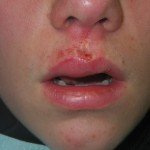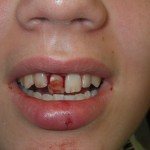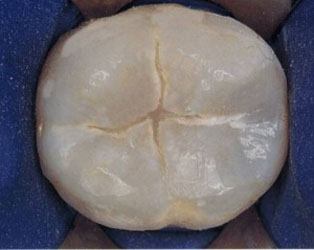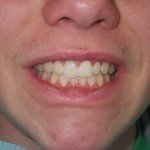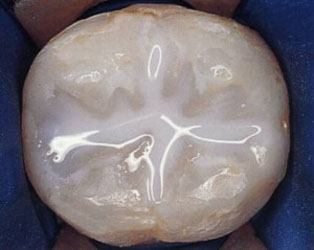Children’s Dentistry
Although Dr Wilson is most known for performing emergency services and full-mouth reconstruction, he loves to treat children! His patience and gentle manner enable him to bring out the best in younger patients. So, please feel free to bring your kids to our office.
This boy whose name is Dylan bumped his teeth. Dr. Wilson painlessly repositioned the tooth. The 3rd photo was taken one week later.
The chewing surface of a molar typically has thin grooves where food and cavity causing bacteria can accumulate.
A sealant can be applied to seal up the grooves.
Dental Sealants for Children and Adults
What are dental sealants?
A dental sealant (also called a pit and fissure sealant) is a professionally-applied plastic that can be placed onto the chewing surfaces of back teeth to prevent cavities. These surfaces have tiny pits and fissures (grooves) that can trap food and cavity-causing bacteria. A sealant has an adhesive and it resembles nail polish because it is a thick liquid, which can be applied into the grooves and then harden. It can seal the grooves and prevent penetration by food and bacteria.
When should my child get dental sealants?
The adult teeth that are most likely to have grooves are molars and pre-molars. The ideal time to place a sealant in a tooth is as soon as possible after it erupts into the mouth. Adult first molars erupt at about age 6. The second molars and both pre-molars usually appear between 10 and 12. Therefore, the ideal age to place sealants varies from tooth to tooth.
Are dental sealants just for kids?
The potential to develop pit and fissure decay (cavities) begins early in the life of a tooth, and sealants can not help areas that have already become decayed. However, many adults have non-decayed teeth that are at risk of developing decay. Those who eat sugary foods or drink coffee or tee, which can stain the grooves (and provide a sticky attachment for bacteria) may be at risk for future cavities, and helped by sealants. Also adults who take medicines or have medical conditions that reduce their ability to produce saliva (which can help wash away foods and bacteria) may benefit from sealants.
How long do sealants last?
The longevity of a sealant depends upon many factors. The adhesive bonds best to dry teeth. However, it is sometimes difficult during the sealant placement to isolate a tooth from saliva in small mouths. The back teeth undergo a lot of pounding during chewing, which can cause a sealant to break out. Even if the visible part of a sealant falls out some of it remains lodged within the tooth’s pores and continues to protect it. However, once a sealant becomes damaged it should be replaced with another sealant as soon as possible.
Do dental sealants eliminate the need for people to use fluoride?
No. Fluorides, such as those used in community water, toothpastes, gels, varnishes, and mouth rinses also help to prevent decay, but they work best on the smooth surfaces of teeth. Fluoride can also benefit adults. When sealants and fluorides are used together they dramatically reduce the likelihood of dental cavities.
What is the fee for a sealant?
Our fee for a sealant is $38. Many insurance carriers provide 100% coverage for sealants up until age 16.
Alternatives to Sealants
Why do some teeth need sealants and others need fillings?
Our back teeth have grooves on their chewing surfaces. They can trap food, dirt and bacteria, yet are frequently too narrow for our toothbrushes to clean. Bacteria eat the sugary foods that get trapped in the grooves, then digest and convert them into an acid waste product that is similar to our urine. This acidic discharge can eat through and soften the teeth. We refer to the softened area that contains food and bacteria as decay or a cavity. A dental sealant (also called a pit and fissure sealant) is a professionally-applied plastic that can be placed onto the grooves to prevent bacteria penetration and cavities. Once bacteria and food penetrate the grooves sealants may not prevent further tooth destruction because the bacteria can continue living off of the food. The decay needs to be removed from the tooth and the resulting area must be filled. If the resulting defect is small then a material, which is capable of flowing into nearby grooves yet strong enough to better resist biting stresses can be placed. This material is called a flowable resin and this type of procedure is referred to a preventative resin restoration (PRR). Bacteria can cause deeper and wider destruction. Once the decay is removed the defect may be large enough for a material that can be packed rather than flowed. It must also be stronger because it will be more exposed to biting forces. This material can be a composite resin and this type of procedure is called a composite restoration filling.
What type procedure is needed in my situation?
Sometimes the size of decay can be determined before treatment by visual or radiographic (x-rays) means. Other times a groove contains a stain or a soft defect (which are both made up of food and bacteria) and the extent of damage is not easy to measure. A tiny excavating tool can remove the decay as wide and deep as it has penetrated. Once the area is clean and the size of the defect is known it can be restored with the appropriate material.
If you need immediate care, contact us at 610-906-8882.
24 Hour Emergency Dentist
***


